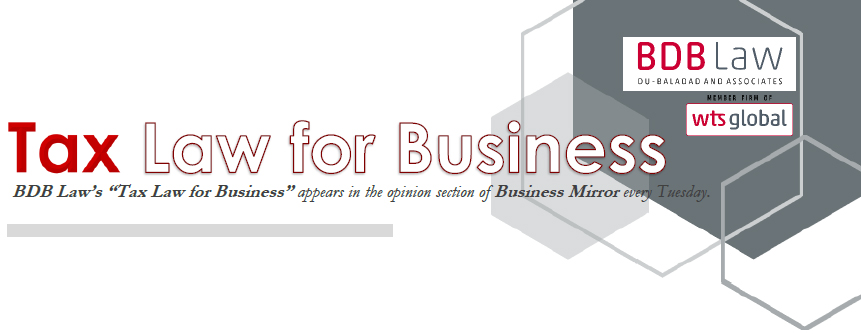
The Opportunities of Artificial Intelligence in Tax
By: Atty. Jomel N. Manaig
"Both the BIR and taxpayers have been using AI, in one form or another, in their processes. However, we should all remember that even with the world’s most advanced AI, it still boils down to the quality of information being entered into the system."
The beginning of 2023 brought some very significant events to my humble career. Among the most high profile is attending the induction ceremony of the new officers of the Management Association of the Philippines. I had the opportunity to rub elbows with some industry titans and leaders. It was a real treat for a young professional such as myself. Yes, yes. I said young so please just indulge me.
In that ceremony, I was very fortunate to meet a gentleman that I may describe as a “logistics guru” - a veritable pundit in his field. In our tête-à-tête, he put forward a very interesting question: “How do you think the rise of artificial intelligence (AI) would affect your profession or field?”
Cliché as it may sound, I thought the timing of the question was a bit serendipitous. As a way or enriching knowledge, I was reading on developments in AI the past few months or so. In the news the past couple of weeks was the introduction of ChatGPT, an AI chatbot that has gained notoriety due to its believable responses and answers. Before that, there was the AI program developed by Midjourney which generates images based only on text inputs and descriptions.
 ChatGPT was able to answer exam questions from a law school in Minessota and got a passing grade. On the other hand, Midjourney was able to create stunning images just from a few words typed in a keyboard and with absolutely no brushstroke. It just shows the power of AI. So, going back to our logistics savant’s question, how would it affect my field? Specifically, how do I think it will affect tax?
ChatGPT was able to answer exam questions from a law school in Minessota and got a passing grade. On the other hand, Midjourney was able to create stunning images just from a few words typed in a keyboard and with absolutely no brushstroke. It just shows the power of AI. So, going back to our logistics savant’s question, how would it affect my field? Specifically, how do I think it will affect tax?
Long answer short, AI can make tax administration more accurate.
For the BIR, using AI to analyze inputs (also known as machine learning) in tax returns and processing the resulting data could make analysis more effortless and would contribute to a more efficient tax examination. AI may also be designed in such a way that analysis could take into account certain circumstances attendant in a particular transaction.
AI may also assist the BIR in strategic decision-making. Sound data-analytics can direct the BIR’s efforts and limited resources to certain high-risk transactions and taxpayers thereby increasing the likelihood of actually unearthing inaccuracies in tax reporting and even tax fraud. This is a better alternative to letters of authority being issued left and right to taxpayers that are compliant when it comes to tax reporting.
Transfer pricing is an area of tax which the competent use of AI would be beneficial. AI may be used to perform the process of comparison with comparable entities or transactions instead of having it done manually.
For taxpayers, AI may be used to simplify the various rules and regulations and help organizations flag doubtful transactions or tax treatments. It would raise the compliance level of the taxpayers and avoid looming tax exposures.
With all the benefits of AI, does it mean that tax professionals like me may lose their jobs in the near future? Fortunately, that may not be the case.
It should be noted that the use of technology is not something new in tax administration. Both the BIR and taxpayers have been using AI, in one form or another, in their processes. However, we should all remember that even with the world’s most advanced AI, it still boils down to the quality of information being entered into the system.
To illustrate, the current version of ChatGPT is only trained on data through September 2021. In other words, ChatGPT is still unable to respond or give answers to questions requiring information that came about later than September 2021. For the Midjourney AI, the quality of the image would depend on how well the description is worded. If the writer is not that eloquent in describing what they envision, then the Midjourney AI may find it more difficult to create the desired image.
Applying AI limitations to tax, if declarations made by taxpayers are inaccurate, reliance by the BIR on those declarations in their assessments would always be problematic. On the other hand, if the BIR would rely on these faulty declarations, then it is not maximizing its efforts and the taxpayer would simply provide detailed explanations as a defense.
For now, fellow tax professionals, we may still give a collectively sigh of relief. Our jobs seem to be secure… for the time being.
The author is a junior partner of Du-Baladad and Associates Law Offices (BDB Law), a member-firm of WTS Global.
The article is for general information only and is not intended, nor should be construed as a substitute for tax, legal or financial advice on any specific matter. Applicability of this article to any actual or particular tax or legal issue should be supported therefore by a professional study or advice. If you have any comments or questions concerning the article, you may e-mail the author at This email address is being protected from spambots. You need JavaScript enabled to view it. or call 8403-2001 local 380.




